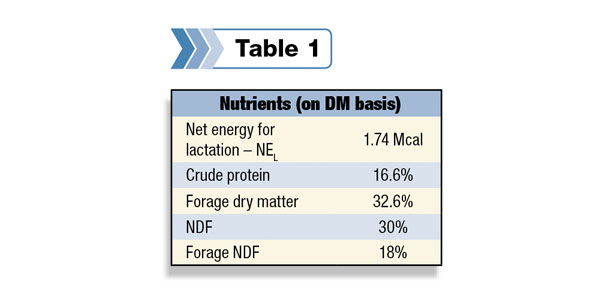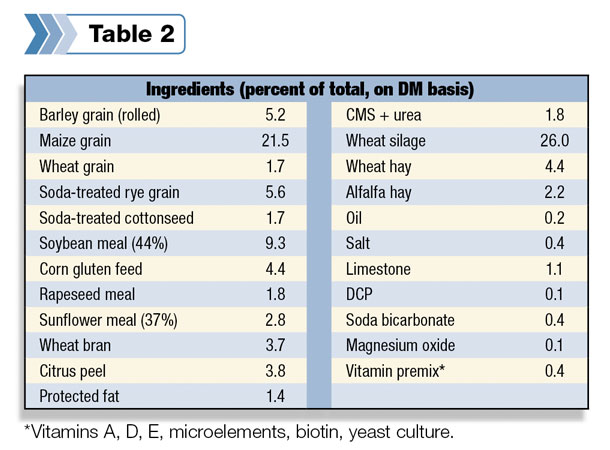The general approach for dairy feeding in Israel today is to maintain two feeding groups: one for early lactation and another for the rest of the milking cows. In family farms, the one-diet method is the most popular. Ad libitum feeding, mainly with a TMR and minimal transfer of cows between groups, is the preferred feeding method in Israel.
Feed intake
Group feeding systems using a mixer wagon with scales represent an important management tool for dairy farms: It improves feed efficiency, rumen fermentation and provides control of feed intake.
An average daily feed intake in dry matter (DM) ranges from 3 to 4 percent of a cow’s bodyweight (BW) and is influenced by milk yield, days after calving, ration composition, neutral detergent fiber (NDF) content, forage-to-concentrate ratio, particle size and density of the ration. In Israel, the influence of the hot season contributes to a 10- to 15-percent decline in feed intake in summer, as compared to winter.
Feed intake, especially for cows at peak lactation, constitutes the major limiting factor for providing nutrients. This is the starting point in any system for rationing and planning. Perhaps in the future, if we count with protected proteins and fats, we will be able to overcome the limitation of conventional energy intake.
By feeding TMR ad libitum, we can record the group’s feed intake, but not of individual cows. It appears that the maximum individual intake by high-yielding cows reaches up to 4 percent of BW (or NDF intake up to 1.3 percent of BW).

Energy level
Until the end of the ’70s, the Scandinavian feed unit (FU) system was commonly employed for rationing in Israel. It used the average norm of 5 FU per day for maintenance and 0.3 to 0.4 FU per kg of milk. Since the available amount of roughage is limited, this led to feeding cows 17 to 18 kg of concentrates per day, resulting in low feed efficiency.
With the increased use of the metabolic and net energy (ME, NEL) systems and their higher evaluation of roughage, the importance of roughage was emphasized. Evidently, manipulation of the feeding level cannot be achieved just by changing the amount of concentrates.
Today it is common to use the ME/NEL system for energy evaluation and NDF or acid detergent fiber (ADF) for intake and energy estimation.
Israeli dairies use NRC 89 recommendations along with local experience as the main guidelines for feeding high-producing dairy cows.
Under the local low-quantity and low-quality roughage conditions, high-energy concentration is a common practice. The energy concentration for high-yielding cows is 1.74 to 1.75 Mcal NEL per kg of DM. Ration fat is 3 to 5 percent, and various sources of starches are always included.
Protein
Years ago, 500 to 550 grams of crude protein for maintenance was a typical allowance, with about 70 g per kg of milk. Today, in the TMR system, 16 to 16.7 percent crude protein is the requirement for high-yielding cows (in summer and winter, respectively).
About 34 to 36 percent of the total protein is undegradable intake protein, and a large variety of protein sources is a common solution to cover the needs for the different amino acids. Cows in early lactation may be given 18 to 19 percent protein of DM.
Fiber
Under Israel’s feeding conditions, it is important to estimate the animal’s requirement for NDF, which will allow normal rumen function.
The use of intermediate feeds, such as wheat bran or orange peel, takes the amount of NDF to a total of 6 to 6.6 kg per day (about 13 pounds, 30 to 34 percent of total DM), but forage NDF is not more than 3.4 to 3.6 kg (about 7.5 pounds, 17 to 18 percent of total DM). Particular attention must be paid to the physical structure of feeds; straw and similar stuffs, when finely chopped, lose some of their efficiency as roughage.

Additional measures
For a correct design of rations, especially when using computerized linear programming, there are some basic assumptions, which may not have any justification in literature or in research but which appear to influence feed intake and performance based on field experience under local conditions.
Regarding intermediate feeds, feeds containing large amounts of highly digestible carbohydrates – such as orange peels – are limited to 15 percent of total DM. This group of foodstuffs also includes liquid whey, which is extensively used in dairy feeding.
In the summer, feed intake declines. At that point, it is recommended to provide better quality forage to minimize climatic effects. Cooling cows with sprinklers and ventilation can lower body temperatures by 1 to 2ºC and enhances feed intake.
Example of an Israeli ration for lactating cows
Under Israel’s conditions, water availability and cost are large problems. Therefore, the forage content in most cow diets is only about 30 percent.
In addition, most of the protein sources and grains are imported, so their availability depends on supply and costs at international markets. To overcome such handicaps and to cover gaps in our nutritional knowledge, the most popular solution while formulating rations is to include a large variety of ingredients.
General observations
Ad libitum feeding of dairy cows has been the common practice in Israel since the ’50s. The goal is to take full advantage of the genetic potential of the animal. However, the main problems we deal with remain:
- How to increase intake andenergy supply
- How to deal with digestibility of feeds, especially when very good forage is not available or in reduced supply
- How to balance maximum yields with maximum profit
It seems that simple and properly balanced diets, minimum transfer of cows between groups with the support of good housing, health control, fertility and breeding are the keys to success for any dairy farm.
Visit the website for details on dairy seminars and dairy tours in Israel. PD
Ofer Kroll is a manager for the Israeli Dairy School.
PHOTO
The Israeli Dairy School in Kibbutz Degania B is located near the Sea of Galilee in Israel. Photo courtesy of Ofier Langer.






